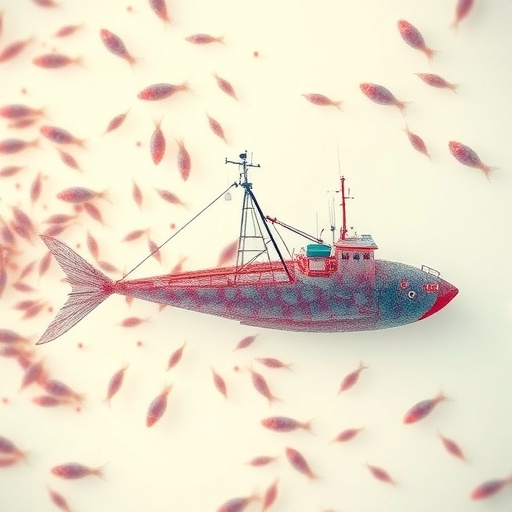Antarctic krill, a small shrimp-like crustacean, is fundamental to the Southern Ocean’s ecological balance, acting as a crucial intermediary between microscopic plant plankton and a vast array of higher predators including seals, penguins, fish, and baleen whales. Recent scientific insights underscore the urgent need for a paradigm shift in the management of krill fisheries to preserve this keystone species amid rising fishing pressures. This urgency is accentuated by the role Antarctic krill occupy in the marine food web and their growing commercial exploitation for purposes ranging from aquaculture feed to nutritional supplements rich in omega-3 fatty acids.
The biomass of Antarctic krill is estimated to be staggeringly vast, ranging between 300 to 500 million tonnes, positioning it among the most plentiful multi-organism species globally. This abundance not only sustains ecological diversity but also supports commercial activities that have expanded significantly in recent decades. Harvesting of krill has increased in regions adjacent to Antarctica, with products derived from krill being incorporated into a variety of commodity goods including cosmetics and animal feed. However, reliance on historic catch data and outdated biomass surveys, primarily a large-scale assessment conducted in 2000, has revealed crucial deficiencies in current management strategies.
The International Commission for the Conservation of Antarctic Marine Living Resources (CCAMLR) is the primary regulatory body tasked with overseeing krill fisheries within the Southern Ocean. The forthcoming annual CCAMLR meeting in Hobart, Australia, scheduled for late October, is set to prioritize discussions on advancing sustainable fishery management protocols. At the forefront of these deliberations is the innovative approach advocated by an international research team led by Dr. Bettina Meyer of the Alfred Wegener Institute. Their proposed framework seeks to tightly intertwine scientific surveillance with commercial fishing operations, transforming the latter from mere extractors to active research allies.
Current monitoring mechanisms have notable limitations, as they omit critical biological data that could illuminate population structure and dynamics. Since 2020, regulations have mandated the presence of scientific observers aboard krill fishing vessels to gather parameters like size, sex, and reproductive maturity of catches. Yet, this invaluable data remains underutilized within official stock assessments. The research advocates for a comprehensive utilization of fishing vessels as floating laboratories, equipped with acoustic echo sounders to map krill swarms in real time, complemented by systematic recording of predator sightings and haul composition analyses.
Integrating these diversified data streams promises a robust, multidimensional picture of krill populations that transcends the episodic snapshots currently available. This strategy enables region-specific identification of sensitive spawning grounds and critical feeding hotspots for dependent fauna. For fisheries management, such granular insights are transformative, allowing for spatially and temporally optimized catch quotas, closures, and seasonal restrictions that minimize ecological disruption while sustaining economic viability.
Notably, the concentration of krill fishing is notably localized within the Atlantic sector of the Southern Ocean, particularly around key areas such as the Antarctic Peninsula, South Orkney Islands, and South Georgia. Despite their wide distribution, fishing activity has predominantly clustered in these hotspots, prompting CCAMLR in 2009 to subdivide catch quotas into four sub-areas to discourage overexploitation within any single zone. The maximum permissible catch has been set at 0.62 million tonnes overall, with tighter restrictions applied to the high-activity sub-area 48.1. However, recent failures to reach consensus on quota continuation rules have led to significant overfishing in this sensitive region.
By July of the current year, krill catches in sub-area 48.1 more than doubled, surpassing 0.4 million tonnes and triggering a full quota exhaustion for area 48 for the first time in history. The ramifications for krill stocks and the predator species that tightly depend on them remain uncertain but undoubtedly raise alarms regarding the resilience of the ecosystem. This overharvesting episode illustrates the peril of inadequate governance frameworks and the importance of deploying adaptive management informed by real-time scientific data.
Dr. Meyer stresses the practicality of their approach amidst political and economic realities, acknowledging that an outright ban on krill fishing is improbable given the vested interests. Instead, fostering a symbiotic relationship wherein commercial stakeholders contribute actively to data collection and research funding represents a pragmatic path forward. This alliance not only optimizes resource utilization but also enhances the scientific foundation upon which management decisions are built.
Regular, high-frequency data acquisition facilitated by fishing vessels provides longitudinal datasets capable of tracking seasonal and interannual fluctuations in biomass and population demographics. Concurrently, industry financial support aligned with research initiatives could amplify the scale and scope of international monitoring programs, ensuring continuity and comprehensive coverage. This collaborative model exemplifies how science-industry partnerships can reconcile conservation goals with economic imperatives.
The sustainable management of Antarctic krill fisheries embodies a critical frontier in marine conservation and ecosystem stewardship. By harnessing technological advancements like acoustic surveys and deploying integrative biological assessments, the scientific community aspires to safeguard this linchpin species amidst a rapidly changing climate and escalating anthropogenic exploitation. The ongoing deliberations within CCAMLR will be pivotal in codifying this forward-looking approach, potentially setting a precedent for global fisheries governance.
Ultimately, the balance achieved will reflect our collective commitment to preserving the intricate web of life in the Southern Ocean, where Antarctic krill plays an irreplaceable role. This research not only advances ecological understanding but also elevates the conversation on sustainable seafood production in one of the planet’s most vulnerable yet vital marine ecosystems.
Subject of Research: Animals
Article Title: Adjusting the management of the Antarctic krill fishery to meet the challenges of the 21st century
News Publication Date: 8-Sep-2025
Web References: http://dx.doi.org/10.1073/pnas.2412624122
Image Credits: Alfred Wegener Institute / Carsten Pape
Keywords: Ecology, Fisheries management




